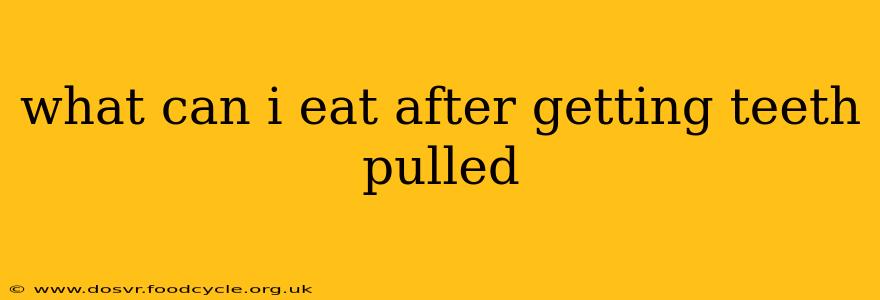What Can I Eat After Getting Teeth Pulled? A Guide to Post-Extraction Nutrition
Getting teeth pulled can be a bit daunting, but knowing what to eat afterward can significantly impact your healing process and comfort. This guide will cover everything you need to know about post-extraction nutrition, answering common questions and offering helpful tips.
What should I eat immediately after tooth extraction?
In the immediate hours following a tooth extraction, it’s crucial to focus on soft, cool foods that won't disturb the extraction site. Avoid anything that requires chewing or could dislodge the blood clot forming in the socket. Excellent choices include:
- Popsicles: The coldness numbs the area and the smooth texture is ideal.
- Applesauce: Smooth, easy to swallow, and provides some nutrients.
- Yogurt (full-fat): Full-fat yogurt offers protein and is gentle on the gums.
- Smoothies (avoid straws!): Blend fruits and vegetables for a nutrient-rich, easy-to-consume meal. Just be cautious not to suck the smoothie through a straw, which can disrupt the blood clot.
- Ice cream (soft serve is best): Offers soothing coldness and is easy to consume.
What foods should I avoid after tooth extraction?
For at least the first 24-48 hours, steer clear of these foods:
- Anything that requires chewing: This includes crunchy foods like chips, nuts, and raw vegetables. Chewing can dislodge the blood clot and cause a painful dry socket.
- Hot foods and drinks: Heat can increase inflammation and bleeding.
- Straws: The sucking motion can dislodge the blood clot.
- Spicy foods: These can irritate the sensitive extraction site.
- Alcohol and smoking: These hinder the healing process and increase the risk of infection.
What are some good soft foods to eat after tooth extraction?
As you start to heal, you can gradually introduce more variety into your diet, always prioritizing soft foods that are easy to swallow and won't irritate the extraction site. Here are some examples:
- Mashed potatoes: A classic comfort food that's both nutritious and easy to eat.
- Scrambled eggs: A great source of protein.
- Oatmeal: A filling and comforting breakfast option.
- Soups (broth-based): Choose soups with finely chopped or pureed vegetables.
- Pasta (well-cooked): Opt for soft pasta shapes and avoid anything with hard, crunchy additions.
- Well-cooked vegetables (pureed or finely chopped): Ensure they are soft and won't cause irritation.
How long should I eat soft foods after tooth extraction?
The length of time you need to stick to a soft food diet depends on the complexity of the extraction and your individual healing process. Your dentist or oral surgeon will provide specific guidance, but generally, it's recommended to stick to soft foods for at least a week. You can gradually reintroduce firmer foods as your mouth feels comfortable.
What nutrients are important for healing after tooth extraction?
Proper nutrition plays a critical role in healing. Focus on consuming foods rich in:
- Protein: Essential for tissue repair.
- Vitamin C: Promotes collagen production, important for wound healing.
- Iron: Helps prevent anemia, which can hinder healing.
- Calcium: Supports bone regeneration.
Remember to stay hydrated by drinking plenty of water. Avoid using a straw! Following these guidelines will help ensure a smooth and efficient recovery. Always follow your dentist or oral surgeon's specific post-operative instructions. If you experience excessive bleeding, severe pain, or any other concerns, contact your dental professional immediately.
